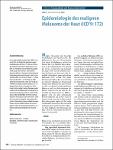Epidemiologie des malignen Melanoms der Haut (ICD'9: 172)
Bertz, Joachim
Das maligne Melanom der Haut (MM) verursacht 90% der Todesfälle durch bösartige Neubildungen der Haut. 2% aller auftretenden Krebskrankheiten in Deutschland sind MM. Die Patienten sind im Mittel etwa zehn Jahre jünger als Patienten mit anderen Krebskrankheiten. Die altersstandardisierten Erkrankungsraten von Männern und Frauen an MM haben sich in Deutschland – im Saarland und der DDR – seit Anfang der 70er Jahre bis Ende der 80er Jahre auf 7 bis 8 pro 100 000 im Europastandard mindestens verdoppelt. Diese Entwicklung fand in ähnlichem Maße in allen Ländern Europas und in Ländern mit Bevölkerungen vorwiegend europäischen Ursprungs statt. Im Unterschied dazu ist die Sterblichkeit an MM in weit geringerem Maß angestiegen. Bei Frauen blieb der erwartete Anstieg der altersstandardisierten Sterberaten nahezu vollkommen aus. Frauen weisen darüber hinaus bei nahezu gleicher Höhe der Erkrankungsraten um ein Drittel niedrigere Sterberaten als Männer auf. 90% of all skin cancer death in Germany is caused by malignant Melanoma (MM). MM is responsible for about 2% of all cancer cases diagnosed in Germany. On average Melanoma-patients are about 10 years younger than other cancer-patients. The age standardized incidence rates of males and females at least doubled in the German cancer registries of the Saarland and the German Democratic Republic in the 20 years during the seventies and eighties, reaching 7–8 per 100,000 European standard-population. Similar increases have been observed in other European countries as well as in countries with populations of mostly European origin outside Europe. In contrast to incidence the increase of age standardized mortality rates is less steep. For females there is nearly no increase of mortality at all. Furthermore, females have mortality rates, which are about one third lower than those of males.
Dateien zu dieser Publikation
Keine Lizenzangabe

